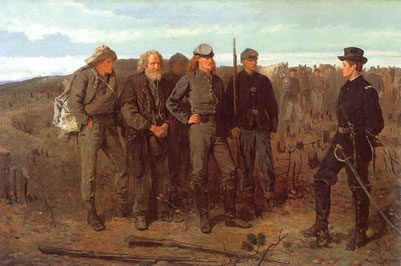Scene & Title Reunited: Homer's 'Fingerprint'

Homer's 'Fingerprint'
On April 28, 1866 The Evening Post continued its criticism of Homer’s style this time regarding his ultimately famous painting Prisoners from the Front 1866 (Fig. 2-11) … as an example of painting it is simply and strongly painted, a little black in color, a little rude in execution, but vital, vigorous, and with no defect of manner which Mr. Homer may not conquer (2.23).
To place an historical reference to Homer’s ‘finish’ criticism, it is important to recall that even the much maligned French impressionists had not yet even been heard of in 1866. Homer’s style preceded impressionism, although his painterly principles were much the same as theirs, he was truly ahead of his time and showed that he painted the way he did with a conscious will. That American art critics at the time, influenced by Victorian ways and romanticized European standards of art, viewed Homer’s style of painting as unfinished and rude simply underscores the uniqueness of Homers Civil War paintings. Because Homer had his own style and manner of placing paint on the canvas which was different than other American painters of his time, analysis of his paintings is much like examining a finger print of the man himself. His dedication to his own ideas of art, his use of complementary colors, light effects, defining distances along with his unique application of paint pigments, all become the identifying trade marks of Homer Civil War paintings.
Watching the Shot. © 2025 All rights reserved. Terms of Use and Privacy Policy

